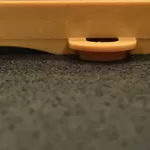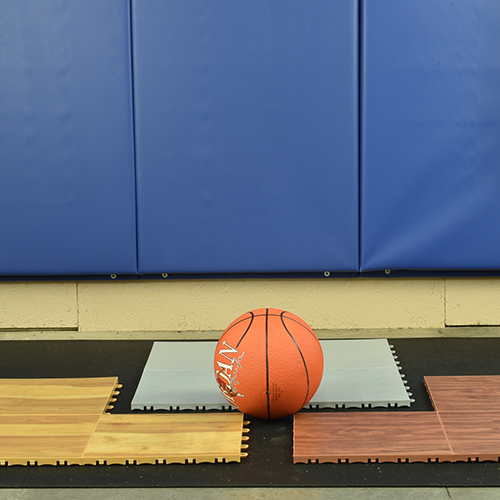Rubber Flooring for Basketball Court - Good Idea or Not?
Related Product: Rubber Floor Underlayment 2 mm x 4x50 Ft. Roll
Rubber Basketball Court Traction
For one thing, basketball courts need just the right amount of traction. Too much traction and athletes are hindered. Too little traction and players lose control. Most rubber products provide too much friction for players to be able to move about freely. With all the stopping, starting and cutting that goes on, too much traction can be almost as dangerous as none.Rubber Basketball Court vs. Shoes
Another less obvious reason is the way floor surfaces interact with basketball shoes. Athletes must protect their feet and joints by choosing supportive shoes that bode well with the flooring surface. Shoes last longer and are more protective when kept clean and new. A rubber basketball court chews up standard basketball shoes, gets them dirty and wears them out much more quickly than other surfaces do.Rubber basketball court-related Injuries
Overall, rubberized surfaces can do more to increase basketball-related injuries than to protect players from them. In addition to the ankle sprains, knee sprains and stubbing that can occur because there's too much traction, rubber flooring for basketball typically does not provide enough give to be supportive of joint and limb health. In order for rubber basketball court flooring to provide enough bounce for the basketball, it would have to be extremely dense. Thus, a rubber basketball floor would be hard like concrete. Hard surfaces without give can lead to ''jumper's knee'' or problems with the with the patella, which connects the kneecap to the shin bone.What Is the Ideal Basketball Floor?
 Clearly, rubber flooring for basketball is not ideal. If a rubber basketball court isn't the way to go, then what is?
Clearly, rubber flooring for basketball is not ideal. If a rubber basketball court isn't the way to go, then what is?
Classic materials for a basketball court include wood for indoor play and concrete for outdoor. Wood is the standard choice for college and professional basketball, especially maple, which provides the right amount of traction, bounce and flexibility.
These days, however, there are more and more surface options. Different synthetic materials are fabulous for basketball courts or multi-purpose sport floor courts.
Modular Basketball Floor Tiles
 In particular, interlocking sports flooring court tiles have grown in popularity. These tiles are typically constructed of a durable plastic material designed to withstand heavy loads. Sports floor court tiles are often a more economic basketball flooring choice because they can be easily assembled by hand. Plus, the user has all of the creative freedom. With interlocking game court tiles, one can choose from a variety of fun colors, and it is simple to construct the floor to fit any desired area.
In particular, interlocking sports flooring court tiles have grown in popularity. These tiles are typically constructed of a durable plastic material designed to withstand heavy loads. Sports floor court tiles are often a more economic basketball flooring choice because they can be easily assembled by hand. Plus, the user has all of the creative freedom. With interlocking game court tiles, one can choose from a variety of fun colors, and it is simple to construct the floor to fit any desired area.
For example, one of Greatmats' most popular modular sport outdoor court tile is the Compete Indoor Court Tile. These tiles connect with a unique tab and loop connecting system, and they are a breeze to assemble and disassemble. Putting tiles together is as easy as lining them up and snapping them into place. Plus, they come in a large selection of colors and can be painted with court lines.
Where Rubber Comes Into Play In a Basketball Floor
 With any interlocking, modular tile, it is important to take advantage of a subfloor. That is where rubber comes in for the win. Rubber underlayment rolls are the perfect basketball floor subsurface. Rubber can provide cushion, which ultimately improves the safety of athletes. Plus, it acts as sound insulation and lowers the high levels of noise on a basketball court. Clearly, a completely rubber basketball floor is no good, but it does wonders underneath the surface of any indoor basketball court.
With any interlocking, modular tile, it is important to take advantage of a subfloor. That is where rubber comes in for the win. Rubber underlayment rolls are the perfect basketball floor subsurface. Rubber can provide cushion, which ultimately improves the safety of athletes. Plus, it acts as sound insulation and lowers the high levels of noise on a basketball court. Clearly, a completely rubber basketball floor is no good, but it does wonders underneath the surface of any indoor basketball court.
Greatmats offers a wide variety of rubber products that make top-notch basketball court underlayment. A few things are the same across the board for Greatmats' rubber products: each basketball floor subsurface is extremely long-lasting, tough and affordable. Some customer favorites include 2mm and 3mm rubber underlayment.
Other Basketball Court Flooring Options
 Greatmats sells a variety of high-quality, affordable athletic court flooring in addition to the best possible basketball court underlayment. Popular products include interlocking game court tiles, rubber-backed vinyl rolls, vinyl gymnasium flooring, and outdoor basketball court flooring tiles.
Greatmats sells a variety of high-quality, affordable athletic court flooring in addition to the best possible basketball court underlayment. Popular products include interlocking game court tiles, rubber-backed vinyl rolls, vinyl gymnasium flooring, and outdoor basketball court flooring tiles.
All of Greatmats' products come in different shapes, colors, sizes and costs so customers can always find the perfect fit. You can check out all of Greatmats' athletic court flooring options at Greatmats.com. There, you will also find the assistance and support you need to make your dream court become a reality.



